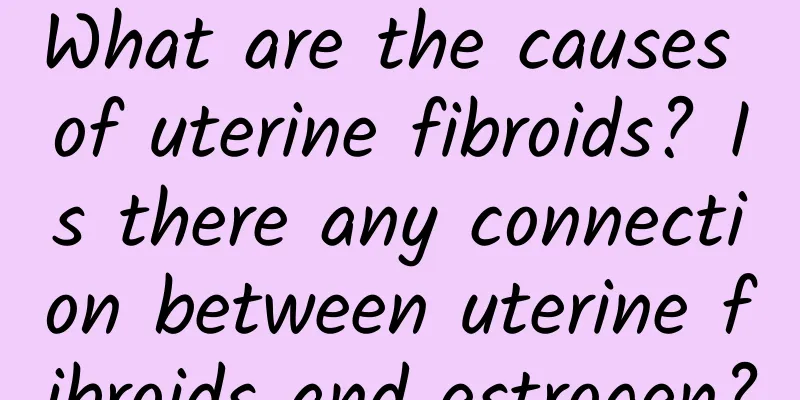What are the causes of uterine fibroids? Is there any connection between uterine fibroids and estrogen?

|
Uterine fibroids are the most common benign tumors of the female reproductive organs. The incidence of uterine fibroids in women of childbearing age is about 20% to 25%. What are the symptoms and hazards of uterine fibroids? How to choose various treatment methods? Does uterine fibroids affect fertility? Uterine fibroids cause a lot of gynecological problems Case 1: The patient had been experiencing heavy and irregular vaginal bleeding for a year. When she went to see a doctor, it was so severe that she had to change her sanitary napkin every hour for four of the seven days of her menstrual period. The heavy bleeding often made the patient feel exhausted. Later, it was found that she had submucosal uterine fibroids. Imagine if she had heavy bleeding every time during her menstrual period, the body might not be able to produce enough blood cells in time to replenish the lost blood. If the condition is mild, iron supplements can be taken to make up for the lack of blood. Some women with uterine fibroids have too much bleeding to rely on iron supplements, so they suffer from anemia, weakness, fatigue, dizziness, etc. Case 2: A patient told the doctor that she could no longer sit and watch a two-hour movie because she had to get up twice to go to the bathroom. In the office, she often had to leave her seat to go to the bathroom, which not only affected her concentration but also reduced her productivity. Case 3: After more than a year of marriage, she finally got pregnant, but the good times didn’t last long. She miscarried after more than two months of pregnancy. She got pregnant again a year later, but also miscarried. A check-up at the hospital revealed that she had several uterine fibroids. After surgery to remove the fibroids and taking contraceptive measures for two years under the doctor’s advice, she finally gave birth to a baby. The cause of uterine fibroids is still unclear and may be related to estrogen In the past decade, the incidence of uterine fibroids has shown an upward trend. The cause of uterine fibroids is still not fully understood. In addition to age, race and family factors, female sex hormones, namely estrogen and progesterone, play an important role in the occurrence and development of uterine fibroids. At present, in our daily food, some irresponsible breeders add female hormones to fatten and ripen aquatic products and livestock, resulting in the residual hormones in their products easily entering our bodies. On the other hand, some irresponsible manufacturers often add excessive amounts of sex hormones to some cosmetics, skin care products, and cream products. Many of these sex hormones can be absorbed into the body by the skin. These exogenous hormones are also one of the reasons for the rising incidence of uterine fibroids. Therefore, before we fully understand the cause of uterine fibroids, the preventive measures in daily life are to eat more green foods, use less cosmetics and skin care products, and when you must use cosmetics, it is also recommended to remove makeup in time to avoid long-term contact. Most small, slow-growing uterine fibroids have no symptoms. Many patients discover uterine fibroids only after symptoms appear or during a physical examination. The symptoms of uterine fibroids are mainly determined by the location, size and complications of the fibroids. Uterine fibroids explained in three cases In case 1, the fibroids caused the patient to have long-term heavy bleeding, which in turn caused secondary anemia, which had a serious impact on both life and work. This patient must be treated. In case 2, the patient had a larger intramural or subserosal fibroid. She did not have bleeding symptoms like the patient in case 1, but showed obvious compression symptoms. Because the uterus is located in the pelvic cavity, it is usually not palpable from the abdomen. Even when the uterine fibroid grows to a size that resembles a three- or four-month pregnancy, the patient may not be able to feel the mass herself. The volume of the pelvic cavity is fixed, with the bladder in front of the uterus and the rectum behind it. When the uterine fibroid is larger, it will compress these organs, causing the patient to frequently have the urge to defecate. Some severe cases may also compress the ureter, causing ureteral dilatation or even hydronephrosis. Therefore, treatment is also necessary when there is obvious compression. Case 3 is an obvious example of uterine fibroids affecting pregnancy and causing miscarriage. For infertile patients like this, after excluding other causes, surgery must be considered to remove the fibroids, and the patient can usually give birth successfully after the surgery. The author once removed more than 40 uterine fibroids for a patient at one time. However, since the uterus of such patients is traumatized after surgery, in order to avoid the risk of uterine rupture caused by premature pregnancy, it is generally required to wait two years after surgery before getting pregnant for safety reasons. Related articles: How long does it take to get pregnant after myomectomy? Is it safe to choose non-invasive or minimally invasive treatment for uterine fibroids? Surgery is necessary to treat uterine fibroids More than 70% of uterine fibroids will recur. |
>>: Can poor sexual life also lead to uterine fibroids? There are three ways to treat fibroids
Recommend
Women should pay attention to the symptoms of vaginitis as early as possible
The occurrence of vaginitis has disrupted the liv...
Correct health care measures for dysmenorrhea
At present, many women do not pay attention to dy...
Does losing a uterus affect sexual intercourse? Doctors admit: Satisfaction is actually increased
In this fast-paced modern life, who doesn't h...
How to regulate irregular menstruation for women? Self-care methods for irregular menstruation
During menstruation, women's resistance is re...
Why does cervical erosion affect pregnancy?
Cervical erosion is not a disease, but a manifest...
How to check for abnormal vaginal discharge
Abnormal vaginal discharge can be checked through...
Jogging for weight loss is super "cool"! Here are 4 good reasons for you
Whether it is ball games, mountain climbing, swim...
How to diagnose cervicitis
Cervicitis is a common gynecological disease that...
What are the symptoms of adenomyosis?
What are the symptoms of adenomyosis? Many people...
If you want to lose weight, the key lies in your lower body! Check if your butt is strong enough
There are two kinds of people in this world, but ...
Drink this to create a slim waist! Chinese medicine doctor Chen Meifei reveals: 3 teas to lose weight and slim your belly
If you want to have a slim and graceful waist lik...
Why do we need to check for uterine fibroids during premarital examinations?
Why should uterine fibroids be checked during pre...
Some points to pay attention to when performing artificial abortion
Artificial abortion is not necessarily caused by ...
What are the dietary precautions for Bartholinitis?
What should you pay attention to in your diet whe...
Ovarian cyst classification Women gain weight and should beware of ovarian cysts
Ovarian cysts are a broad category of ovarian tum...









